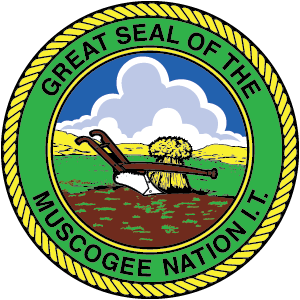Ancestors at rest: Repatriation at Ocmulgee
by: Amanda Rutland/MCNPR
MACON, Ga. — It was a cool morning with clouds floating heavy overhead. The hum of a backhoe penetrated the quiet as it broke the earth to prepare for the task at hand.
Members of the National Parks Service, the Muscogee (Creek) Nation and other tribal nations gathered Aug. 30 to repatriate 113 individuals back to Ocmulgee National Monument in Macon, Ga. As the ceremony started MCN Historic and Cultural Preservation employee Emman Spain said the proceedings would be simple and respectful.
“There is no ceremony that is supposed to happen because it has happened and we have to do things like this,” Spain said. “Because we don’t know these ceremonies and talking to a lot of our elders and a lot of our cultural advisors, they told us, ‘you know it may be disrespectful to start trying to make things up’.”
Spain asked that no photos or video be taken in order to protect the site. He invited anyone who wanted to help or participate to do so.
HCP Manager RaeLynn Butler explained that this repatriation was not a regular type of funeral.
“These remains have been in limbo for a long time. They were dug up in the ‘30s and this is one of the largest archeological sites in the southeast,” Butler said. “Some of those remains went to the Smithsonian and some went to the National Parks Service and over the last 15 years, have been working to get those back into the possession of the tribes.”
Butler explained this was a joint repatriation and it could not be said that this was only for one tribe.
“These are our relatives and at one time we were all one tribe in this area,” Butler said. “We feel that our relatives need to be respected and back into the ground where they came from.”
NPS and tribal employees began carefully unloading gray containers, the size of filing boxes, from a vehicle and placing them in a neat line next to the burial area.
The seemed like the box couriers were ants making lines back and forth to the nest, efficient and with purpose. It was extremely quiet as they worked, like Nature was holding her breath.
One person lifted the lid off a gray box and removed a small bundle wrapped in a white soft cloth. She handed it gingerly to someone else who placed it inside the burial area.
“There is no coffin, there is no caskets, but they have been wrapped in all natural fiber cloth so they can go back to the soil,” Butler said.
Soon there were white bundles laid out in rows, which was a stark contrast to the red dirt surrounding them. The parcels varied in size, but each one was an individual, an ancestor.
After the 113 bundles were placed, the lead individuals took shovels and began to cover them with the red earth. After a layer of soil was established, shovels were offered to anyone that wanted to help.
Shovels migrated through different hands they took turns. It was a serious occasion, but also an uplifting one to know that these Mvskoke people can once again be at peace.
“It is for them to continue their journey,” Spain said.




